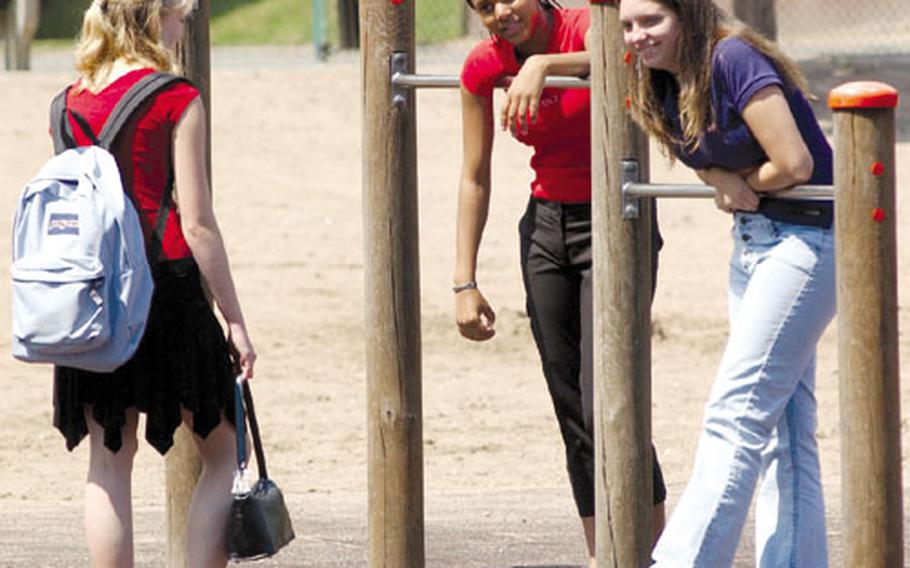
From left, Melonie Pyle, Angelica Thomas and Briane Hall chat about the upcoming school year wearing some of the latest fashions. (Raymond T. Conway / S&S)
SCHWEINFURT, Germany – The day after Venée Hummel finished middle school last spring, her clothes closet got a big-time makeover.
In went bracelets, necklaces, studded leather wristbands, jeans, colorful blouses and jackets. Out went the hated red, white and blue of her Schweinfurt Middle School uniform.
“Everybody’s happy when they get to high school,” said Venée, 14, who will start her freshman year at Würzburg American High School in Germany on Sept. 7. “They don’t have to wear [uniforms] anymore.”
Five years ago, the Schweinfurt community voted “yes” to requiring pupils at its two elementary schools and one middle school to adopt a dress code of red, white or blue tops, along with navy or white pants, or skirts for girls. Elementary schools in Ansbach and Heidelberg followed suit, and Bamberg is joining the uniform parade this year. The dress codes outline what colors or combinations of colors a pupil must wear to school, but do not dictate a “school uniform,” as such.
The codes also bar some types of jewelry, clothes with logos, sweat suits, jeans, baggy clothes, flip-flop sandals, platform shoes and multicolored socks.
“I like it,” said Sgt. Shannon Walls, whose 7-year-old son, Trey, attends Bad Kissingen Elementary School near Schweinfurt. “It’s real easy to get my son dressed in the morning.”
But even in families where Mom or Dad puts on military fatigues every day, many kids chafe at such a strict dress code.
“I think we’re all against uniforms,” said Christopher Obee, 13, an eighth-grader at Schweinfurt Middle School. “We should be able to express ourselves with our clothes.”
The aim of the codes is to boost grades by cutting peer pressure and eliminating what the Rainbow Elementary dress code describes as “fashion show behavior.” They’re also meant to root out gangs by preventing members from wearing distinctive clothes.
But kids are ingenious at working around the codes. They make fashion statements with decorations on their backpacks and binders, with low-key jewelry and with shoes.
“I tried wearing 10 key chains on my wrist, but I got yelled at,” said Venée’s sister Darnelle Hummel, 10, a fifth-grader at Schweinfurt Elementary.
In Schweinfurt, undershirts are hot. The uniform policy doesn’t address them, so kids can wear any color they like under their red, white or blue polo. Christopher said it is seriously cool for middle-school boys, once at school, to take off their shirts and expose their white T-shirts — which meet the dress code — like 1950s greasers.
The dress code offers enough wiggle room that schoolyard cliques can find ways to stand out. Venée said one group at her school — she calls them the “ghetto girls” — stands out by wearing the same tight slacks with white shirts and blue sweat shirts. All very elitist, and perfectly legal under the code.
Carol Sturm, a veteran fourth-grade teacher in Schweinfurt, said she’s heard little fuss about uniforms. She said violations are rare, especially after the first few weeks of school.
Pupils say enforcement of the dress code isn’t always consistent.
“My [fourth-grade] teacher was not strict at all. Kids would come to school wearing jeans,” Darnelle said. “But the teacher next door, if you had even one key chain showing, you’d get in trouble.”
It is not lost on the kids, or their parents, that teachers and staff don’t have to follow a dress code.
“Teachers can walk around in pink and yellow,” Darnelle said.